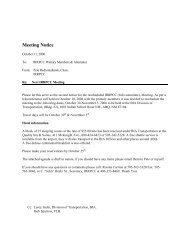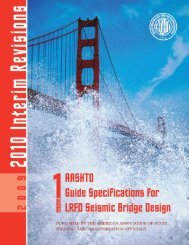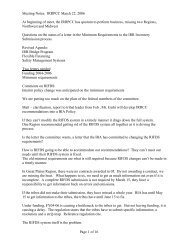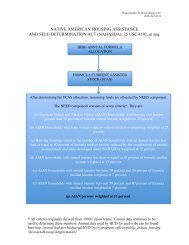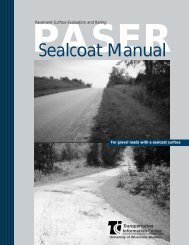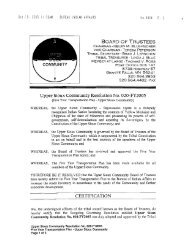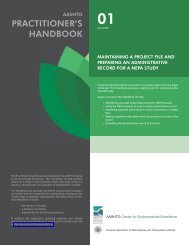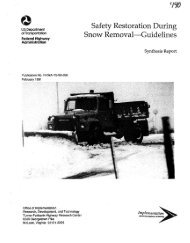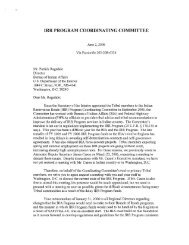Safety in Welding, Cutting, and Allied Processes
Safety in Welding, Cutting, and Allied Processes
Safety in Welding, Cutting, and Allied Processes
Create successful ePaper yourself
Turn your PDF publications into a flip-book with our unique Google optimized e-Paper software.
ANSI Z49.1:1999<br />
4.2.2.10 Ma<strong>in</strong>tenance. Helmets, h<strong>and</strong>shields, <strong>and</strong><br />
goggles shall be well ma<strong>in</strong>ta<strong>in</strong>ed, <strong>and</strong> should not be transferred<br />
from one employee to another without be<strong>in</strong>g<br />
cleaned.<br />
4.3 Protective Cloth<strong>in</strong>g. Cloth<strong>in</strong>g shall be selected to<br />
m<strong>in</strong>imize the potential for ignition, burn<strong>in</strong>g, trapp<strong>in</strong>g hot<br />
sparks, or electric shock.<br />
E4.3 Heavier materials such as woolen cloth<strong>in</strong>g or heavy<br />
cotton are preferable to lighter materials because they are<br />
more difficult to ignite. Cotton cloth<strong>in</strong>g, if used for protection,<br />
should be chemically treated to reduce its combustibility.<br />
Cloth<strong>in</strong>g treated with flame resistant materials<br />
may lose some of its protective characteristics after repeated<br />
wash<strong>in</strong>g or clean<strong>in</strong>g. Materials which can melt <strong>and</strong><br />
cause severe burns should not be used as cloth<strong>in</strong>g when<br />
weld<strong>in</strong>g or cutt<strong>in</strong>g.<br />
Sparks may lodge <strong>in</strong> rolled-up sleeves, pockets of cloth<strong>in</strong>g,<br />
or cuffs of overalls or trousers. It is therefore recommended<br />
that sleeves <strong>and</strong> collars be kept buttoned <strong>and</strong> pockets<br />
be elim<strong>in</strong>ated from the front of cloth<strong>in</strong>g. When pockets<br />
are present, they should be emptied of flammable or<br />
readily combustible materials. Trousers or overalls should<br />
not have cuffs <strong>and</strong> should not be turned up on the outside.<br />
Trousers should overlap shoe tops to prevent spatter from<br />
gett<strong>in</strong>g <strong>in</strong>to shoes.<br />
Frayed cloth<strong>in</strong>g is particularly susceptible to ignition<br />
<strong>and</strong> burn<strong>in</strong>g <strong>and</strong> should not be worn when weld<strong>in</strong>g or cutt<strong>in</strong>g.<br />
Refer to 11.3 <strong>and</strong> 11.4.<br />
4.3.1 Selection. Cloth<strong>in</strong>g shall provide sufficient coverage,<br />
<strong>and</strong> be made of suitable materials, to m<strong>in</strong>imize sk<strong>in</strong><br />
burns caused by sparks, spatter, or radiation.<br />
4.3.2 Gloves. All welders <strong>and</strong> cutters shall wear protective<br />
flame-resistant gloves. All gloves shall be <strong>in</strong> good<br />
repair, dry, <strong>and</strong> capable of provid<strong>in</strong>g protection from electric<br />
shock by the weld<strong>in</strong>g equipment.<br />
4.3.3 Aprons. Durable flame-resistant aprons shall be<br />
used to protect the front of the body when additional protection<br />
aga<strong>in</strong>st sparks <strong>and</strong> radiant energy is needed.<br />
4.3.4 Legg<strong>in</strong>gs. For heavy work, flame-resistant legg<strong>in</strong>gs<br />
or other equivalent means shall be used to give added<br />
protection to the legs, when necessary.<br />
4.3.5 Capes <strong>and</strong> Sleeves. Cape sleeves or shoulder<br />
covers with bibs made of leather or other flame-resistant<br />
material shall be worn dur<strong>in</strong>g overhead weld<strong>in</strong>g, cutt<strong>in</strong>g,<br />
or other operations, when necessary.<br />
4.3.6 Other Protective Cloth<strong>in</strong>g. Properly fitted<br />
flame-resistant plugs <strong>in</strong> the ear canals, or equivalent protection,<br />
shall be used where hazards to the ear canals exist.<br />
E4.2.2.10 For methods of clean<strong>in</strong>g, refer to the<br />
manufacturers <strong>in</strong>structions.<br />
E4.3.1 Appropriate protective cloth<strong>in</strong>g for any weld<strong>in</strong>g<br />
<strong>and</strong> cutt<strong>in</strong>g operation will vary with the size, nature,<br />
<strong>and</strong> location of the work to be performed. Cloth<strong>in</strong>g should<br />
be kept clean, as oil <strong>and</strong> grease can reduce its protective<br />
qualities.<br />
E4.3.2 Gloves made of leather, rubber, or other suitable<br />
materials are recommended. Insulat<strong>in</strong>g l<strong>in</strong><strong>in</strong>gs should<br />
be used to protect areas exposed to high radiant energy<br />
(see E11.2.2).<br />
E4.3.3 Aprons made of leather or other suitable materials<br />
are recommended. Insulated l<strong>in</strong><strong>in</strong>gs should be used<br />
to protect areas exposed to high radiant energy (see<br />
E11.2.2).<br />
E4.3.4 In production work, a sheet metal screen <strong>in</strong> front<br />
of the workers legs can provide further protection aga<strong>in</strong>st<br />
sparks <strong>and</strong> molten metal <strong>in</strong> cutt<strong>in</strong>g operations.<br />
E4.3.6 Dry, hole-free cloth<strong>in</strong>g will usually be sufficient<br />
to adequately <strong>in</strong>sulate the welder from electric shock (see<br />
11.3 <strong>and</strong> 11.4).<br />
9



